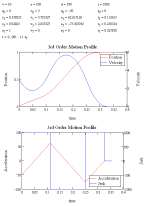SSJVegetto
Member
Hello everyone,
I'm currently working on a system where motion is involved. The thing I want to do is make calculations for a motion system where there is also a jerk.
Is there anyone who knows how to calculate the following questions:
I think i have got the distance as a function of time. I managed to calculate the maximum velocity the axis is going to travel at in order for it to move a certain distance. The formula's are quite difficult and I would like to calculate the time as well when the distance is known and also the velocity when I want the axis to move the given distance in the given time.
I need to take into account that the given profile might not reach the desired velocity since then it would overshoot the distance but also that it might not reach the commanded velocity since then it might overshoot the acceleration and/or deceleration.
Anyone here who can help me out?
Kind regards,
Bob
I'm currently working on a system where motion is involved. The thing I want to do is make calculations for a motion system where there is also a jerk.
Is there anyone who knows how to calculate the following questions:
- The distance as a function of time for given distance, velocity, acceleration, deceleration and jerk.
- The time as a function of position for given distance, velocity, acceleration, deceleration and jerk.
- The velocity required for a motion path with given distance, acceleration, deceleration and jerk in a given time.
I think i have got the distance as a function of time. I managed to calculate the maximum velocity the axis is going to travel at in order for it to move a certain distance. The formula's are quite difficult and I would like to calculate the time as well when the distance is known and also the velocity when I want the axis to move the given distance in the given time.
I need to take into account that the given profile might not reach the desired velocity since then it would overshoot the distance but also that it might not reach the commanded velocity since then it might overshoot the acceleration and/or deceleration.
Anyone here who can help me out?
Kind regards,
Bob




